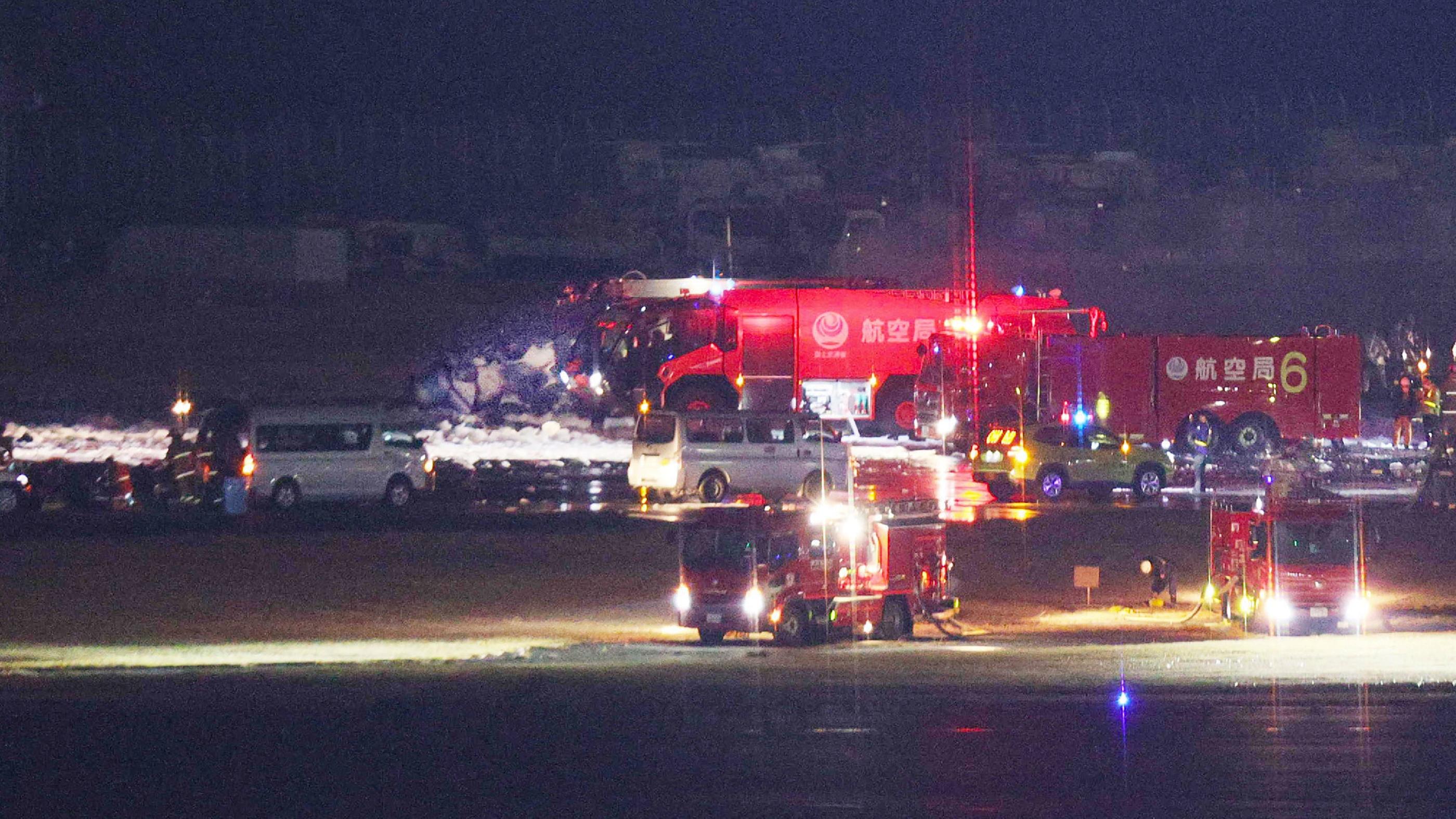 This photo provided by Jiji Press shows firefighters working at the scene of an accident between a Japan Airlines plane and a coast guard aircraft on a runway of Tokyo's Haneda Airport on Jan 2, 2024. (PHOTO / AFP)
This photo provided by Jiji Press shows firefighters working at the scene of an accident between a Japan Airlines plane and a coast guard aircraft on a runway of Tokyo's Haneda Airport on Jan 2, 2024. (PHOTO / AFP)
TOKYO — Japanese authorities said on Wednesday that a passenger jet that collided with a Coast Guard turboprop at a Tokyo airport was given permission to land, but the smaller plane was not cleared for take-off, based on transcripts of conversations with the control tower.
All 379 people aboard the Japan Airlines Airbus A350 had a miraculous escape after it erupted in flames following Tuesday's crash with a De Havilland Dash-8 Coast Guard turboprop shortly after landing at Haneda airport.
Transcripts of traffic control instructions released by authorities appeared to show the Japan Airlines plane had been given permission to land but that the Coast Guard aircraft had been told to taxi to a holding point near the runway
But five died among the six Coast Guard crew who were due to depart on a flight responding to a major earthquake on the west coast, while the captain, who escaped the wreckage, was badly injured.
Authorities have only just begun their investigations and there remains uncertainty over the circumstances surrounding the incident, including how the two aircraft ended up on the same runway.
READ MORE: Five dead after JAL airliner crashes into quake aid plane in Tokyo
But transcripts of traffic control instructions released by authorities appeared to show the Japan Airlines plane had been given permission to land but that the Coast Guard aircraft had been told to taxi to a holding point near the runway.
An official from Japan's civil aviation bureau told reporters there was no indication in those transcripts that the Coast Guard aircraft had been granted permission to take off.
The captain of the Coast Guard plane said he had entered the runway after receiving permission, a coast guard official said, while acknowledging that there was no indication in the transcripts that he had been cleared to do so.
"The transport ministry is submitting objective material and will fully cooperate with the ... investigation to ensure we work together to take all possible safety measures to prevent a recurrence," Transport Minister Tetsuo Saito told reporters.
The Japan Safety Transport Board is investigating the incident, with participation by agencies in France, where the Airbus airplane was built, and Britain, where its two Rolls-Royce engines were made, people familiar with the matter said.
 The burn-out Japanese coast guard aircraft is seen at rear behind the logo of Japan Airline at Haneda airport on Wednesday, Jan 3, 2024, in Tokyo, Japan. (PHOTO / AP)
The burn-out Japanese coast guard aircraft is seen at rear behind the logo of Japan Airline at Haneda airport on Wednesday, Jan 3, 2024, in Tokyo, Japan. (PHOTO / AP)
The JTSB has recovered the voice recorder from the coast guard aircraft, authorities said.
Meanwhile, Tokyo police are investigating whether possible professional negligence led to deaths and injuries, several media, including Kyodo and the Nikkei business newspaper, said.
Police set up a special unit at the airport to investigate and planned to interview those involved, a spokesperson said, but declined to say if they were examining the negligence concerns.
"There's a strong possibility there was a human error," said aviation analyst Hiroyuki Kobayashi, who is a former JAL pilot.
"Aircraft accidents very rarely occur due to a single problem, so I think that this time too there were two or three issues that led to the accident."
READ MORE: Runway safety concerns in focus as Japan probes Tokyo crash
In a statement on Wednesday, JAL said the aircraft recognized and repeated the landing permission from air traffic control before approaching and touching down.
All passengers and crew were evacuated within 20 minutes of the crash, but the aircraft, engulfed in flames, burned for more than six hours, the airline said.
The Coast Guard aircraft, one of six based at the airport, had been due to deliver aid to regions hit by Monday's earthquake of magnitude 7.6 that has killed 64, while survivors face freezing temperatures and prospects of heavy rain.
The accident forced the cancellation of 137 domestic, and four international, flights on Wednesday, the government said.
But emergency flights and high-speed rail services have been requested to ease the congestion, Transport Minister Saito said.


